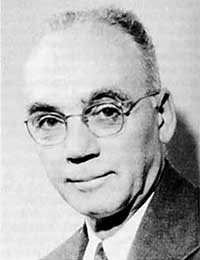Walker Bleakney
Walker Bleakney (February 8, 1901 – January 15, 1992) was an American physicist,[1] one of inventors of mass spectrometers,[1][2][3][4] and widely noted for his research in the fields of atomic physics, molecular physics, fluid dynamics,the ionization of gases, and blast waves.[5] Bleakney was the chair of the department of physics at Princeton University.[5][6] He was the head of the Princeton Ballistic Project during World War II.[5][7]
Walker Bleakney | |
|---|---|
 | |
| Born | February 8, 1901 |
| Died | January 15, 1992 (aged 90) |
| Education | graduate of Echo High School, Echo, OR in 1919; source Bleakney papers; Echo School Records |
| Scientific career | |
| Doctoral advisor | John T. Tate |
Career
Bleakney graduated from Whitman College in 1924 with a BS degree. He received his Ph.D. from the University of Minnesota in 1930.[5] He then spent his entire career at Princeton University, first as a National Research Fellow,[8] then as an instructor in 1932.[5]
He then became an assistant professor in 1935 , an associate professor in 1938 and a full professor in 1944.[5] Bleakney became the chair of the Department of Physics in 1960, and remained in that capacity until 1967.[5]
Early in his career at Princeton, Bleaker was able to make a difference in nuclear physics. For example, he proved that heavy water contains traces of triple-weight hydrogen (1935).[9] In a team with other Princeton physicists he produced Hydrogen 3 in 1934.[10]
Awards and Distinctions
- Walker Bleakney was elected to the National Academy of Sciences in 1959[1]
- National Research Council Fellow, 1930–32[1]
- Citations for World War II research[1]
- Honorary D.Sc., Whitman College, 1955[1]
- American Academy of Arts and Sciences, 1963[1]
- Cyrus Fogg Bracket Professor of Physics, Princeton University, 1953[1]
- Class of 1909 Professor of Physics, Princeton University, 1963[1]
References
- National Academies Press, Biographical Memoirs V.73 (1998), Walker Bleakney by GEORGE T. REYNOLDS
- New York Times:SCIENCE PRODUCES NEW HEAVY WATER; Ten Drops of Tritium Yielded by 'Boiling Down' 75 Tons of Ordinary Water, March 16, 1935
- Measuring mass: from positive rays to proteins By Michael A. Grayson, page 133
- A New Mass Spectrometer with Improved Focusing Properties, Phys. Rev. 53, 521–529 (1938), Walker Bleakney and John A. Hipple, Jr.
- Princeton University Library Manuscripts Division:Walker Bleakney Papers, 1920s-1961
- New York Times:PRINCETON WINS HONOR; Physics Laboratory Gets Atomic Safety Award, September 24, 1961
- Declassified military records, NEW LIMITATION CHANGE TO, ADB279629
- New York Times:SPLIT-SECOND SPEED OF RADIUM CLOCKED; New Device Records Passage of Alpha Particles Ten Millionths of a Second Apart,February 27, 1932
- New York Times:THE WEEK IN SCIENCE: MAN BATTLES WITH THE WINDS; Dust Storms Raise Fears That the West May Become a Sahara -- Whence Come Cosmic Rays? -- Boulder Dam's Life;By WALDEMAR KAEMPFFERT, March 31, 1935,
- New York Times:LAST OF ELEMENTS MADE IN 'QUANTITY'; Princeton Physicists Announce Creation of Hydrogen Three in Tangible Form. FILL GAP IN ATOMIC TABLE Washington Science Session Hears of Synthetic Production From Water.By WILLIAM L. LAURENCE.Special to THE NEW YORK TIMES. April 29, 1934,
Further reading
- R. J. Emrich. Walker Bleakney and the development of the shock tube at Princeton. Shock Wave 5(1996):327–39.